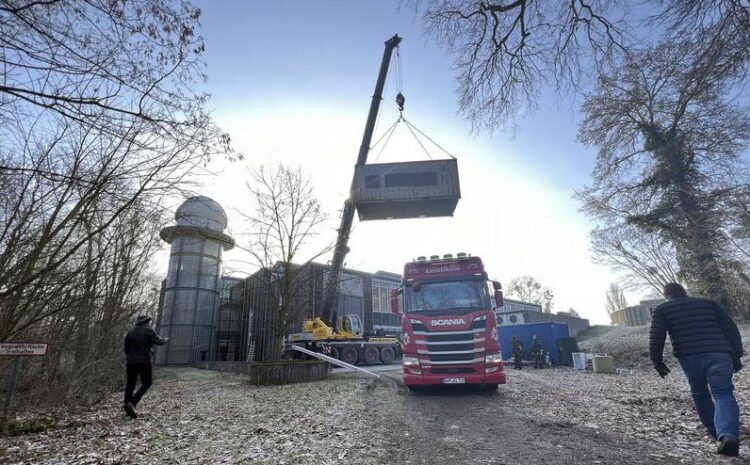4MOST Milestone: First Major Shipment to Chile

4MOST Cable Wrap, Shipment
(c) AIP
Milestone for the 4MOST project: The Leibniz Institute for Astrophysics Potsdam (AIP) will begin shipping the 4MOST instrument to Chile on Thursday 29 February with the first large shipment.
A significant milestone approaches for the 4MOST project as the Leibniz-Institute for Astrophysics Potsdam (AIP) gears up to dispatch the first major shipment of the 4MOST instrument to Chile. On Thursday, February 29, the Cable Wrap, the largest physical subsystem of 4MOST, will commence its journey from AIP’s facilities to the European Southern Observatory’s (ESO) Paranal Observatory in Chile.
„The decision to ship the Cable Wrap early marks a crucial step forward for the project. Rigorously tested by us and by ESO, and meeting all requirements, the subsystem will be installed on the VISTA telescope ahead of the next major 4MOST shipments to Paranal,” says 4MOST project manager Joar Brynnel.“ This proactive approach not only optimizes space in the AIP integration hall but also accelerates the overall timeline, ensuring timely integration and deployment.”
Two sea containers, meticulously packed and components wrapped to shield against dust and humidity, will be handed over to logistics partner DSV. Equipped with a crane for efficient loading, a large truck will transport the containers to the harbor of Hamburg, where they will be embarked onto a large ship bound for Chile. The voyage, spanning five weeks via the Panama Canal, will then continue on trucks via the Pan-American highway and culminate in the delivery of the Cable Wrap to Paranal Observatory.
To accurately track the rotation of stars and other celestial objects throughout the night, the 4MOST instrument requires a precise connection to a significant number of electrical cables, optical fibers, and cooling fluid lines. To safeguard these connections during observation, a Cable Wrap system is employed. This system features an electrical motor that drives energy chains within two c-shaped channels, effectively organizing, guiding, and protecting the cables and fibers simultaneously.
4MOST principal investigator Roelof de Jong, remarked, „The shipment of the Cable Wrap signifies a crucial step towards realizing the full potential of 4MOST. As we inch closer to full science operations in 2025, we remain committed to pushing the boundaries of astronomical exploration. The exceptional instrument will enable many science goals, and especially complement four key space-based, large-area survey observatories of prime European interest: Gaia, Euclid, eROSITA, and PLATO. The first five-year survey of 4MOST consists of 10 programs developed by the Consortium and 15 programs from the ESO community.”
The 4MOST project represents a collaborative effort by the consortium comprising 15 institutes across Germany, Australia, France, the Netherlands, Sweden, Switzerland, and the UK, led by the Leibniz-Institute for Astrophysics Potsdam (AIP). Selected by ESO to furnish the astronomical community with a cutting-edge fibre-fed spectroscopic survey facility, 4MOST will be able to simultaneously obtain spectra of ~2400 objects distributed over a hexagonal field-of-view of 4.2 square degrees.
Wissenschaftliche Ansprechpartner:
Roelof de Jong, 4MOST principal investigator,
Phone: +49 (0)331 7499 648
Email: rdejong@aip.de
Joar Brynnel, 4MOST project manager,
Phone: +49 (0)331 7499 310
Email: jbrynnel@aip.de
Weitere Informationen:
https://www.aip.de/en/news/4most-milestone-first-major-shipment/
Media Contact
All latest news from the category: Physics and Astronomy
This area deals with the fundamental laws and building blocks of nature and how they interact, the properties and the behavior of matter, and research into space and time and their structures.
innovations-report provides in-depth reports and articles on subjects such as astrophysics, laser technologies, nuclear, quantum, particle and solid-state physics, nanotechnologies, planetary research and findings (Mars, Venus) and developments related to the Hubble Telescope.
Newest articles
Faster, more energy-efficient way to manufacture an industrially important chemical
Zirconium combined with silicon nitride enhances the conversion of propane — present in natural gas — needed to create in-demand plastic, polypropylene. Polypropylene is a common type of plastic found…

Energy planning in Ghana as a role model for the world
Improving the resilience of energy systems in the Global South. What criteria should we use to better plan for resilient energy systems? How do socio-economic, technical and climate change related…

Artificial blood vessels could improve heart bypass outcomes
Artificial blood vessels could improve heart bypass outcomes. 3D-printed blood vessels, which closely mimic the properties of human veins, could transform the treatment of cardiovascular diseases. Strong, flexible, gel-like tubes…





















